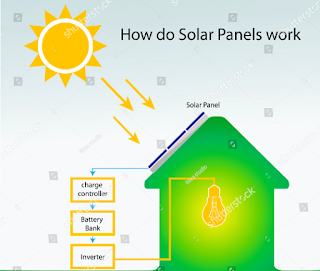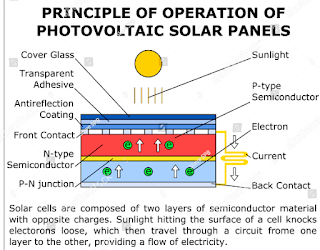A Review Article on Electricity Generation from Solar Energy
Abstract:
The solar energy produced by sunlight is
renewable non-vanishing source of energy which is eco-friendly. The solar
energy can be used to meet the energy demands of the world for a whole year.
This solar energy is produced as per its demand in commercial, industrial and
residential fields. It can easily be generated directly from sunlight. So it is
very efficient and not associated with any environmental pollution. This review
article is concerned with the solar energy from sunlight and its future aspects
and trends. The article also tries to cover the working and types of solar
panels and their applications and also various methods for promoting the
benefits of solar energy.
Keywords: Renewable energy, Photo-voltaic
cell, Solar panel, Modelling of PV Panel, Solar Concrete Collector
I. INTRODUCTION
The last ten years have become more important for per watt cost of
solar energy device because of decreasing amount of renewable energy sources.
It is growing as better technology in terms of cost as well as applications and
certainly set to become economical in the coming years. The sunlight that earth
receives every day is approximately above 1366 W. So an unlimited source of
energy is available without any cost. The solar energy also has major advantage
over other conventional source of power generations that it can be produced
directly from sunlight by using smallest photo-voltaic cells. A large number of
research activities have been carried out to develop solar cells, panels, and
modules with high converting forms. Furthermore, solar energy demands lower
manpower expenses as compared to conventional energy production technologies.
II. SOLAR ENERGY
The amount of energy present in the form of radiations and heat is
termed as solar energy as shown in fig.1. The heat and the radiant light from
the sun is a natural source of energy based on a wide range of ever changing
and developing technologies such as solar architecture, solar thermal energy,
molten solar power plant, solar heating and artificial photosynthesis. The
availability of solar energy on large magnitude provides highly appealing
source of electricity. Only 30% of solar energy is returned back to space while
the rest solar radiations are absorbed by clouds, ocean and masses.
 |
| Figure 1 Internal of Reaction of Solar energy |
III. WORKING OF SOLAR ENERGY
Sunlight is converted to Direct current electricity by
photovoltaic cell PV. The power from solar panel is controlled by charge
controller which controls the power from reverse back in order to avoid panel
damage. The electric power stored in battery is used in the absence of sunlight
such as at night. Inverter connected to this system converts the Direct current
(DC) into Alternating current (AC).
 |
| Figure 2 Working of solar energy |
IV. MODELING OF PV PANEL
A. Solar Cell (Photovoltaic Cell)
Photovoltaic cells converts the solar radiations directly into
electricity. It composition contains different kinds of semiconductor
materials. It may be of two types based
on either positive charge or negative charge as shown in fig.1. Low cost and
high conversion efficiency can be achieved by designing solar cells based on
this cell technology. The photons of sunlight absorbed by the cell knocked out
the electrons from silicon atom and are absorbed by a grid of metal conductors
and produces a flow of electric direct current. Solar cell PV are composed of
various chemicals.
 |
| Figure 3. Operation of Photovoltaic Cell |
B. Photovoltaic Module
Solar cell circuits are sealed in an eco-friendly laminate and are
the basic building blocks of PV system. Their general sizes are from 60W to
170W. Generally, the arrangement involves a large number of PV modules in
series and parallel to fulfil the energy requirements.
C. Photovoltaic Panel
It consists of one or more PV modules arranged as a pre-wind,
field instable unit. In this panel the arrangement of PV cells are in series connection.
Solar panels are composed of individual PV cells that are linked together.
 |
| Figure 5. Photovoltaic Panel |
D. Photovoltaic Array
It consists of several number of PV cells in parallel and series
connection. Voltage of the module is increased by series connection whereas
current in the array is increased by parallel voltage. During full sunshine, it
can generate maximum 180W. The production of solar electricity is directly
related to the total surface area. Greater the surface area, greater will be the
production of solar electricity.
 |
| Figure 6. Photovoltaic array |
V. SOLAR CONCRETE COLLECTORA. PARABOLIC TROUGH REFLECTORS
It consists of linear parabolic reflector that concentrates light
onto a receiver that is positioned along the focal line of the reflector. It
contains a receiver that is a tube placed directly above the middle of the
parabolic mirror and fluid that is working fluid. When working fluid flows
through the receiver, it is heated at 150-350 degree Celsius and then used as a
source of heat for power generation system.
 |
| Figure 7. Parabolic Trough Reflectors |
B. Fresnel
In a Fresnel lens, the surface is designed to produce refraction,
while the large material between the two surfaces does not have any hindrance
in the refraction. It has role in raising the temperature further and also in
heating of furnace. The surface modification of metallic material can be out by
its installation. The application of solar energy in the field of high and very
high temperature can be carried out by this equipment. This equipment can
achieve that temperature within a few seconds. The reflective area can be
reduced by 34.3% by Fresnel concentrator as compared to a parabolic of same
diameter. The manual adjustment in order to track the sun requires a 20 minutes
series of action and has been proved to be a major disadvantage with this
device.1888
 |
| Figure 8. Fresnel Reflector |
C. Parabolic Dish
It is identical in appearance to a large satellite dish, but
contains mirror like reflectors and absorber working as the focal point. It
utilized dual axial sun tracking. The efficiency of 30% can be achieved by it.
MW level in the solar planet has been produced by this dish. This is one of the
highest conversion performance of the concentration solar power technology.
 |
| Figure 9. Parabolic Dish |
D. Central Receiver
It usually utilized in large scale plants that are generally
generating the more amount power. It also termed as “Power Tower”. It works by focusing
a field of thousand number of mirrors on to a receiver positioned at the top of
a centrally located Tower. The receiver receives the sun’s heat transfer fluid,
which is employed to generate stream turbine positioned at the foot of the
tower for generation of Electricity.
1889
VI. MERITS OF SOLAR ENERGY
Up to 20% of the energy cost can be saved by using solar energy.
It can be employed in remote locations. It has easy installation without requirement
of any cords, wires etc. Rooftop is used for its generation and there is no
need of new and every commercial or domestic user can generate their own
electricity. It is generated from the widely available sunlight without any
cost, eco-friendly and renewable energy source. It does not need any additional
fuel, because it does not has any additional moving parts other than sunlight
to generate power. It does not has any need of fuel and water.
VII. DEMERITS OF SOLAR ENERGY
It cannot generate power in the absence of sunlight. It has high
initial cost. It needs more space to generate large amount power. Inverter is
required for alternating Direct current and also its storage is required at
night. The production of PV systems having single silicon crystals is
challenging technically and energy and time consuming.
VIII. APPLICATIONS OF SOLAR ENERGY
.
It is utilized in many applications including
Ø electricity
Ø evaporation
Ø heating water
Ø heating and cooling of buildings
Ø water pumping
Ø cooking food etc.
Figure 11 Application for heating water Figure 12 Application for
Water pumping Fig.13.Application for cooking food
IX. CONCLUSION
Solar energy is now becoming more popular because of its economic
benefits. Solar energy can give electricity 24x7, even at night and on cloudy
days by on battery backup. Continuous power supply can be managed by using with
inter-grid system. It has more benefits in comparison to various other forms of
energy such as petroleum deposits and fossil fuels. It is an alternative which
is consistent and promise in order to fulfil the high energy demand. Research
on solar energy and solar cells is on the way for further future perspectives
worldwide.
REFERENCES
[1] Shruti Sharma, Kamlesh Kumar Jain, Ashutosh Sharma a review on
“Solar Cells: In Research and Applications”,Materials Sciences and
Applications, 2015, 6,1145-1155 Published December 2015 http://dx.doi.org/10.4236/msa.2015.612113
[2] Askari Mohammad Bagher, Mirzaei Mahmoud Abadi Vahid, Mirhabibi
Mohsen. “Types of Solar Cells and Application”. American Journal of Optics and
Photonics.Vol. 3, No. 5, 2015, pp. 94-113. doi:
10.11648/j.ajop.20150305.17
[3] Book of “Wind and Solar Power Plants” by Mukund Patel, CRC
Press
[5] Book of “Solar Energy” by Dr. S. P. Sukhatme. Tata McGraw Hill
Publication.
[6] Gaurav A. Madhugiri, S. R. Karale, “High solar energy
concentration with a Fresnel lens: A Review”Vol.2, Issue.3, May-June 2012
pp-1381-1385 ISSN: 2249-6645.




No comments:
Post a Comment